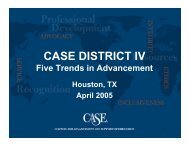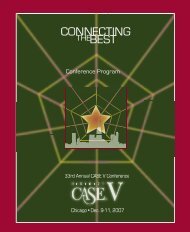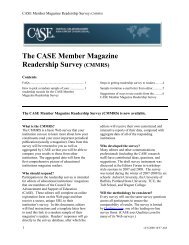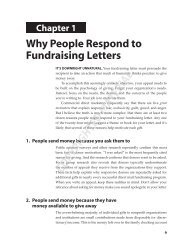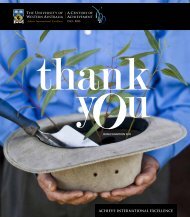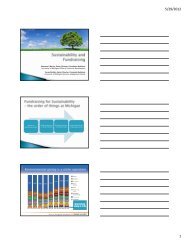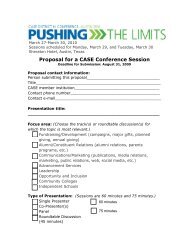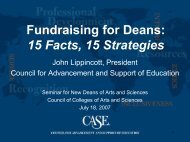You also want an ePaper? Increase the reach of your titles
YUMPU automatically turns print PDFs into web optimized ePapers that Google loves.
A taxi driver feverishly radioed for police; a second cabbie nearby heard<br />
the transmission and flagged down a patrol car. Palme was rushed to a<br />
nearby hospital.<br />
But it was too late. Olof Palme—a much admired, much criticized leader<br />
during a turbulent era—was pronounced dead just after midnight. He was<br />
fifty-nine.<br />
Palme was known for guiding neutral Sweden in a “middle way’’ during<br />
the Cold War between the United States and the Soviet Union. He assailed<br />
South African apartheid, and, at the United Nation’s behest, he attempted<br />
to mediate the Iran-Iraq war. He stridently criticized American involvement<br />
in the Vietnam War, provoking hostility from the U.S. government and<br />
many Americans.<br />
He was also a <strong>Kenyon</strong> graduate, quite possibly <strong>Kenyon</strong>’s most prominent<br />
alumnus on the world stage—a statesman formed in part by a youthful<br />
sojourn in the United States, including a year on the Hill. He left <strong>Kenyon</strong><br />
with lifelong friends and an affection, for both the <strong>College</strong> and America, that<br />
would never flag.<br />
“Lucky to land there”<br />
Palme arrived in Gambier from Sweden at age twenty in the autumn of 1947.<br />
He was an unconventional student at an unconventional time in the<br />
<strong>College</strong>’s history.<br />
“He had wanted to go to school in the States; he never made entirely clear<br />
why,” classmate and longtime friend Henry J. Abraham ’48 said in a recent<br />
interview. “So he turned to his grandfather, who was a Lutheran bishop in<br />
Sweden at the time. His grandfather said he would take care of it, but you<br />
have to agree to one condition. You have to go to a Protestant college.”<br />
Palme sought a scholarship through the American Scandinavian<br />
Foundation. “Suddenly I received a letter from <strong>Kenyon</strong>,” he told the Alumni<br />
Bulletin in a 1984 interview. “I had never heard of the <strong>College</strong>, but as it<br />
turned out I was lucky, extremely lucky to land there.”<br />
He entered <strong>Kenyon</strong> fluent in English, French, and German, with<br />
extensive academic credit from studies in Sweden. He also had served as a<br />
cavalry lieutenant.<br />
At the time, the <strong>College</strong> was flooded with ex-military men, young American<br />
veterans of World War II. Many of them lived in Splinterville, the nickname<br />
for a temporary housing complex built to handle the enrollment bulge.<br />
As a resident of the complex’s large “T barracks,” Palme met Paul Newman<br />
’49; the two would remain friendly throughout their lives. Other friends included<br />
William T. Bulger ’48, who went on to teach history at Central Michigan<br />
University, as well as Abraham, who later taught political science at the University<br />
of Pennsylvania and the University of Virginia, and served as a <strong>College</strong> trustee.<br />
The future prime minister, who majored in economics and political<br />
science, was a straight-A student. But he found time for soccer, which had<br />
just emerged as a varsity sport. Palme wore number 32; Abraham, the team<br />
captain, wore number 37.<br />
Palme worked as a dining hall waiter, said Abraham, who had the same<br />
job. “He received, as we all did, 47 cents per meal and all we could eat. We<br />
put up a sign [reminding the waiters] to wear neckties. And one day he came<br />
in with a necktie and no shirt on. When we took him to task, he pointed to<br />
the sign and said, ‘All you said was wear a necktie.’ ”<br />
Palme spent Christmas of 1947 at the Bulger family home in Flint,<br />
Michigan, and later would reminisce about banging on pans with the Bulgers<br />
to welcome the New Year.<br />
Meanwhile, he honed his progressive social views by visiting an industrial<br />
plant in nearby Mount Vernon. “He spent every weekend exploring the union<br />
standing in the center, wearing number 32, palme played on <strong>Kenyon</strong>’s first<br />
varsity soccer team in 1947. The captain, number 37, was Henry J. “Hank”<br />
Abraham ’48, who remained a friend.<br />
movement,” Abraham said. “He would go to the plant and talk with people.”<br />
The explorations widened. After graduating in 1948—extensive academic<br />
credit from Sweden enabled Palme to finish up at <strong>Kenyon</strong> in just a year—he<br />
hitchhiked through thirty-four states, taking odd jobs when he could.<br />
His American experiences proved to be important. “For the first time, I<br />
came out of isolated Sweden,” he said in a 1971 interview. The cross-country<br />
trip gave him “a good picture of American society. It gave me strong feelings<br />
about social injustices.”<br />
Minister on the rise<br />
Back in Sweden, Palme obtained a law degree and eventually took a job<br />
in the prime minister’s office. In 1957 he was first elected to the Swedish<br />
parliament as a member of the dominant Social Democratic party, the leftleaning<br />
architect of the country’s famous social-welfare system. He joined the<br />
government’s cabinet in 1963 as minister without portfolio. His first official<br />
duty—grimly ironic in retrospect—was to attend the funeral of the assassinated<br />
President John F. Kennedy.<br />
Sweden maintained a neutral stance in foreign policy, attempting to walk<br />
a narrow line between the two Cold War behemoths. Neutrality shouldn’t<br />
mean aloofness, though, in Palme’s view. He joined in a demonstration when<br />
the Soviet Union sent troops into Czechoslovakia in 1968 to repress liberalization.<br />
But it was his criticism of America’s role in Vietnam that brought<br />
him the most publicity.<br />
During the late 1960s, Sweden accepted U.S. military deserters. The country<br />
also had given a modest amount of financial assistance to North Vietnam.<br />
In 1968, when he was minister of education, Palme participated with a North<br />
Vietnamese diplomat in a protest against American involvement in Vietnam.<br />
“The American ambassador (a ranch-owner from Texas) became angry and<br />
went home and we had a magnificent internal row here in Sweden,” Palme wrote<br />
to Bulger. “The opposition demanded that I resign immediately. But I stayed.”<br />
In another letter, Palme told Bulger, “I am deeply worried, disgusted





